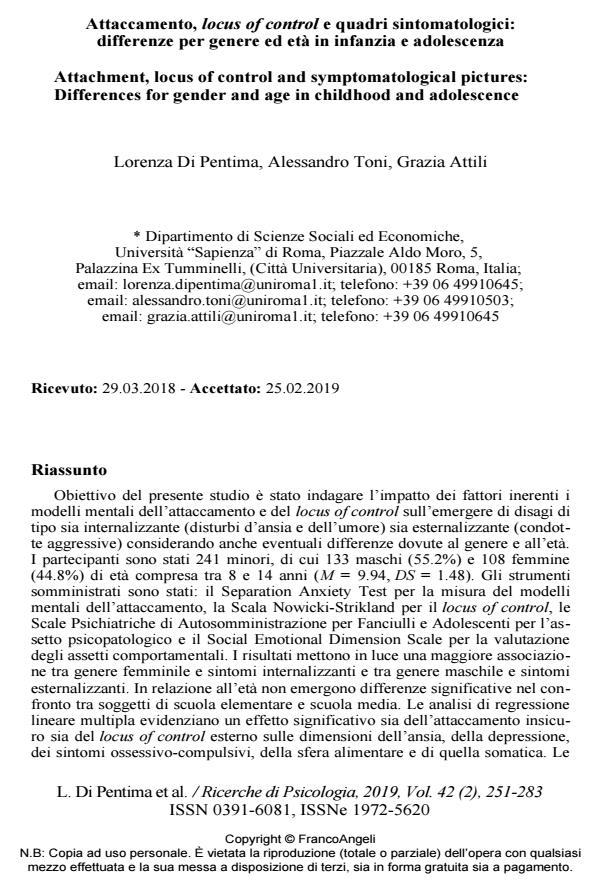Attaccamento, locus of control e quadri sintomatologici: differenze per genere ed età in infanzia e adolescenza
Titolo Rivista RICERCHE DI PSICOLOGIA
Autori/Curatori Lorenza Di Pentima, Alessandro Toni, Grazia Attili
Anno di pubblicazione 2019 Fascicolo 2019/2
Lingua Italiano Numero pagine 33 P. 251-283 Dimensione file 279 KB
DOI 10.3280/RIP2019-002003
Il DOI è il codice a barre della proprietà intellettuale: per saperne di più
clicca qui
Qui sotto puoi vedere in anteprima la prima pagina di questo articolo.
Se questo articolo ti interessa, lo puoi acquistare (e scaricare in formato pdf) seguendo le facili indicazioni per acquistare il download credit. Acquista Download Credits per scaricare questo Articolo in formato PDF

FrancoAngeli è membro della Publishers International Linking Association, Inc (PILA)associazione indipendente e non profit per facilitare (attraverso i servizi tecnologici implementati da CrossRef.org) l’accesso degli studiosi ai contenuti digitali nelle pubblicazioni professionali e scientifiche
Obiettivo del presente studio e stato indagare l’impatto dei fattori inerenti i modelli mentali dell’attaccamento e del locus of control sull’emergere di disagi di tipo sia internalizzante (disturbi d’ansia e dell’umore) sia esternalizzante (condotte aggressive) considerando anche eventuali differenze dovute al genere e all’eta. I partecipanti sono stati 241 minori, di cui 133 maschi (55.2%) e 108 femmine (44.8%) di eta compresa tra 8 e 14 anni (M = 9.94, DS = 1.48). Gli strumenti somministrati sono stati: il Separation Anxiety Test per la misura del modelli mentali dell’attaccamento, la Scala Nowicki-Strikland per il locus of control, le Scale Psichiatriche di Autosomministrazione per Fanciulli e Adolescenti per l’assetto psicopatologico e il Social Emotional Dimension Scale per la valutazione degli assetti comportamentali. I risultati mettono in luce una maggiore associazione tra genere femminile e sintomi internalizzanti e tra genere maschile e sintomi esternalizzanti. In relazione all’eta non emergono differenze significative nel confronto tra soggetti di scuola elementare e scuola media. Le analisi di regressione lineare multipla evidenziano un effetto significativo sia dell’attaccamento insicuro sia del locus of control esterno sulle dimensioni dell’ansia, della depressione, dei sintomi ossessivo-compulsivi, della sfera alimentare e di quella somatica. Le condotte aggressive, invece, sono maggiormente influenzate solo dall’attaccamento insicuro. In particolare nel confronto tra soggetti che non hanno alcun disagio e coloro che presentano sintomi internalizzanti, esternalizzanti oppure entrambe le tipologie di sintomo, emerge una preponderanza di modelli mentali di tipo ambivalente.
Parole chiave:Attaccamento, locus of control, sintomi internalizzanti ed esternalzzanti, genere, infanzia, adolescenza.
- Parenting Styles and Moral Disengagement in Young Adults: The Mediating Role of Attachment Experiences Lorenza Di Pentima, Alessandro Toni, Antonio Roazzi, in The Journal of Genetic Psychology /2023 pp.322
DOI: 10.1080/00221325.2023.2205451 - Dysfunctional Parental Care and Emotional Dysregulation: A Pilot Study on the Mediating Role of Attachment Styles and Alexithymia in a Sample of Young Women Lorenza Di Pentima, Alessandro Toni, in Journal of Adult Development /2025
DOI: 10.1007/s10804-025-09523-z - Attaccamento e disimpegno morale nel fenomeno del bullismo: uno studio su bambini di scuola elementare Lorenza Di Pentima, Sara Ramelli, in RICERCHE DI PSICOLOGIA 3/2020 pp.871
DOI: 10.3280/RIP2020-003005 - L'Adolescent dating aggression: una review sul fenomeno delle violenze di coppia in adolescenza e il contributo della teoria dell'attaccamento Lorenza Di Pentima, Susanna Racalbuto, in SOCIOLOGIA E RICERCA SOCIALE 128/2022 pp.76
DOI: 10.3280/SR2022-128005 - L'impatto della violenza assistita sui minori: attaccamento, locus of control ed esiti psicopatologici Lorenza Di Pentima, Alessandro Toni, Grazia Attili, in MALTRATTAMENTO E ABUSO ALL'INFANZIA 2/2021 pp.83
DOI: 10.3280/MAL2021-002006 - Attaccamento e bullismo: un confronto tra bulli, vittime, bulli-vittime e non-coinvolti in età scolare Lorenza Di Pentima, Sara Ramelli, in MALTRATTAMENTO E ABUSO ALL'INFANZIA 2/2020 pp.119
DOI: 10.3280/MAL2020-002007
Lorenza Di Pentima, Alessandro Toni, Grazia Attili, Attaccamento, locus of control e quadri sintomatologici: differenze per genere ed età in infanzia e adolescenza in "RICERCHE DI PSICOLOGIA " 2/2019, pp 251-283, DOI: 10.3280/RIP2019-002003